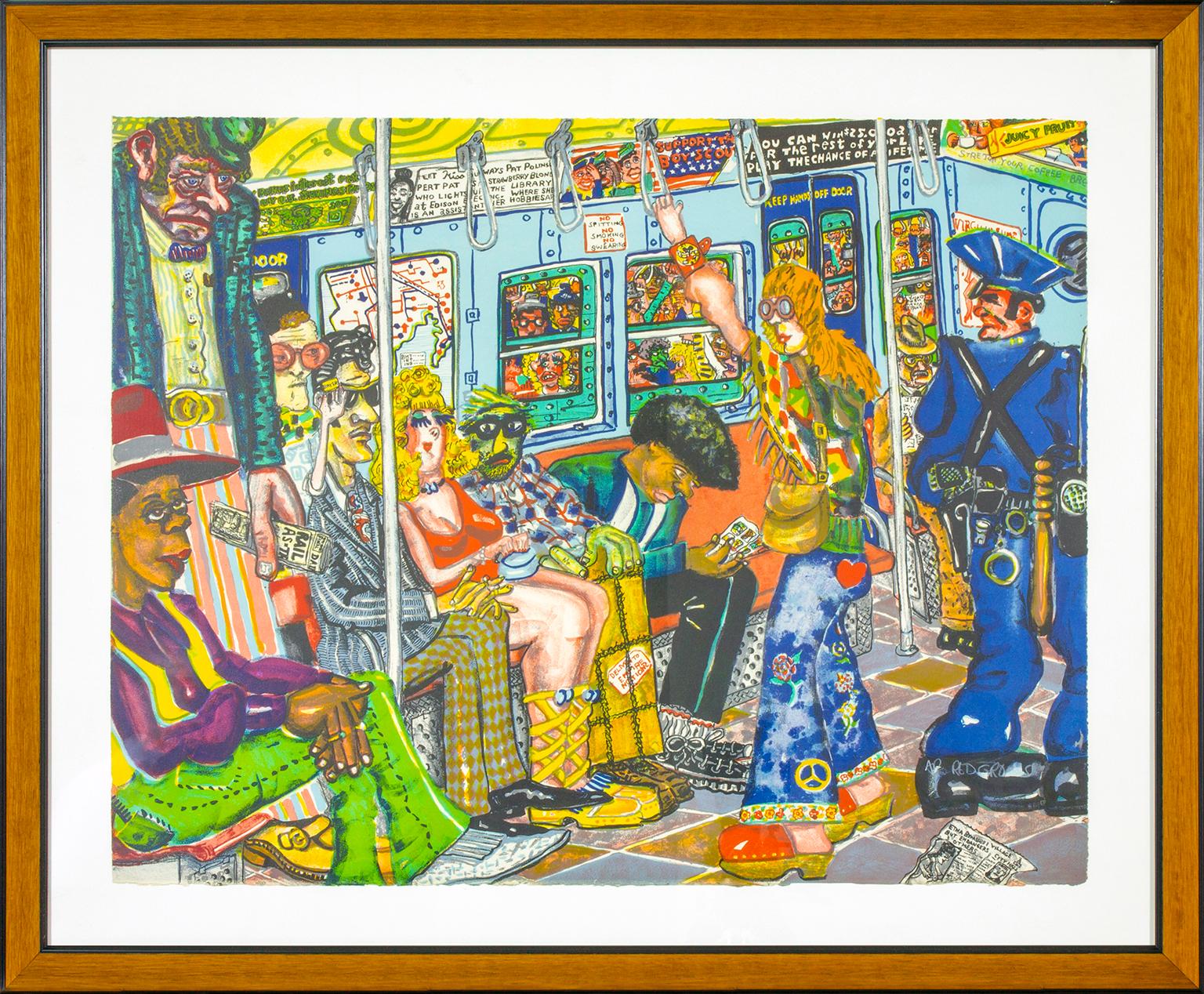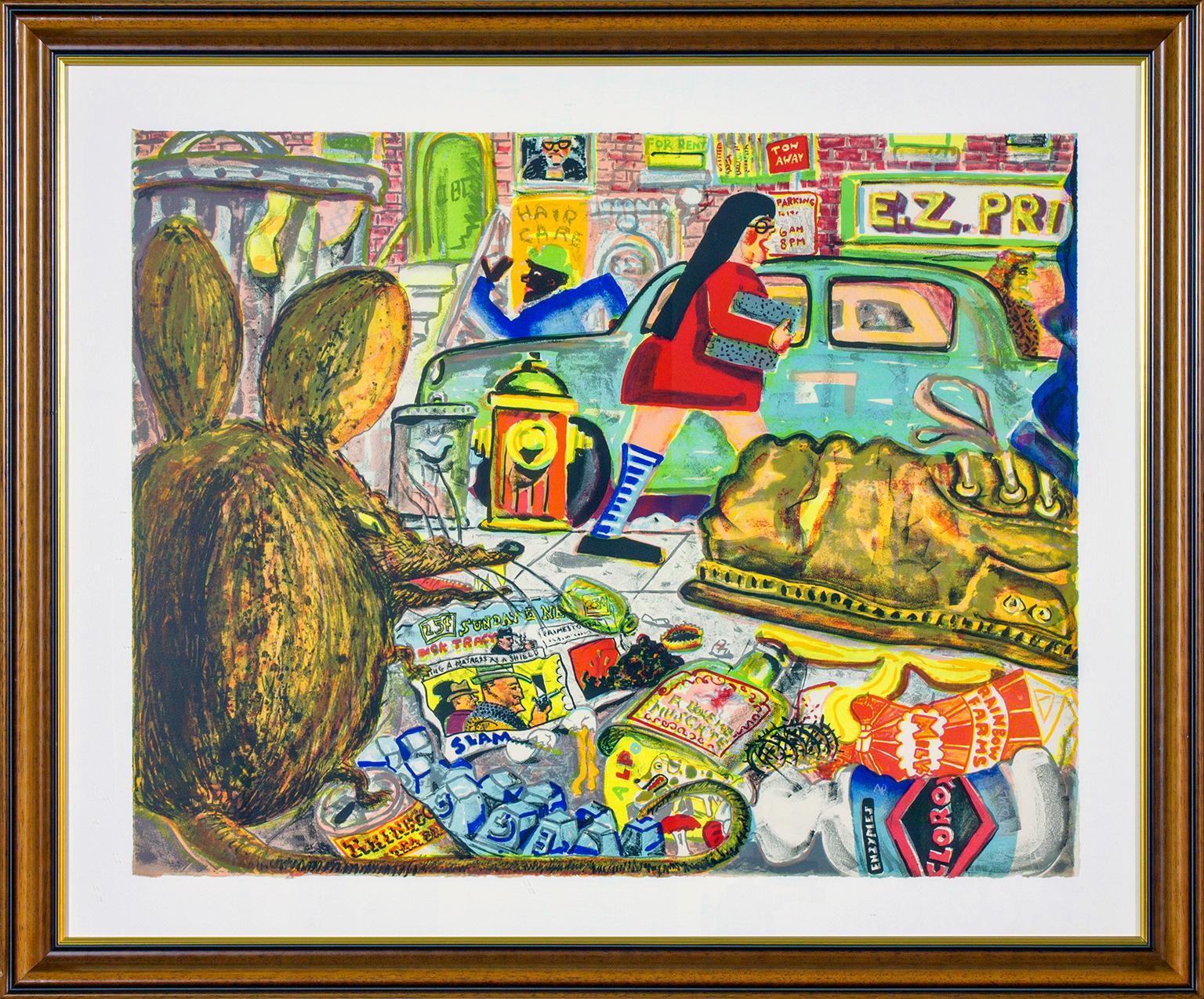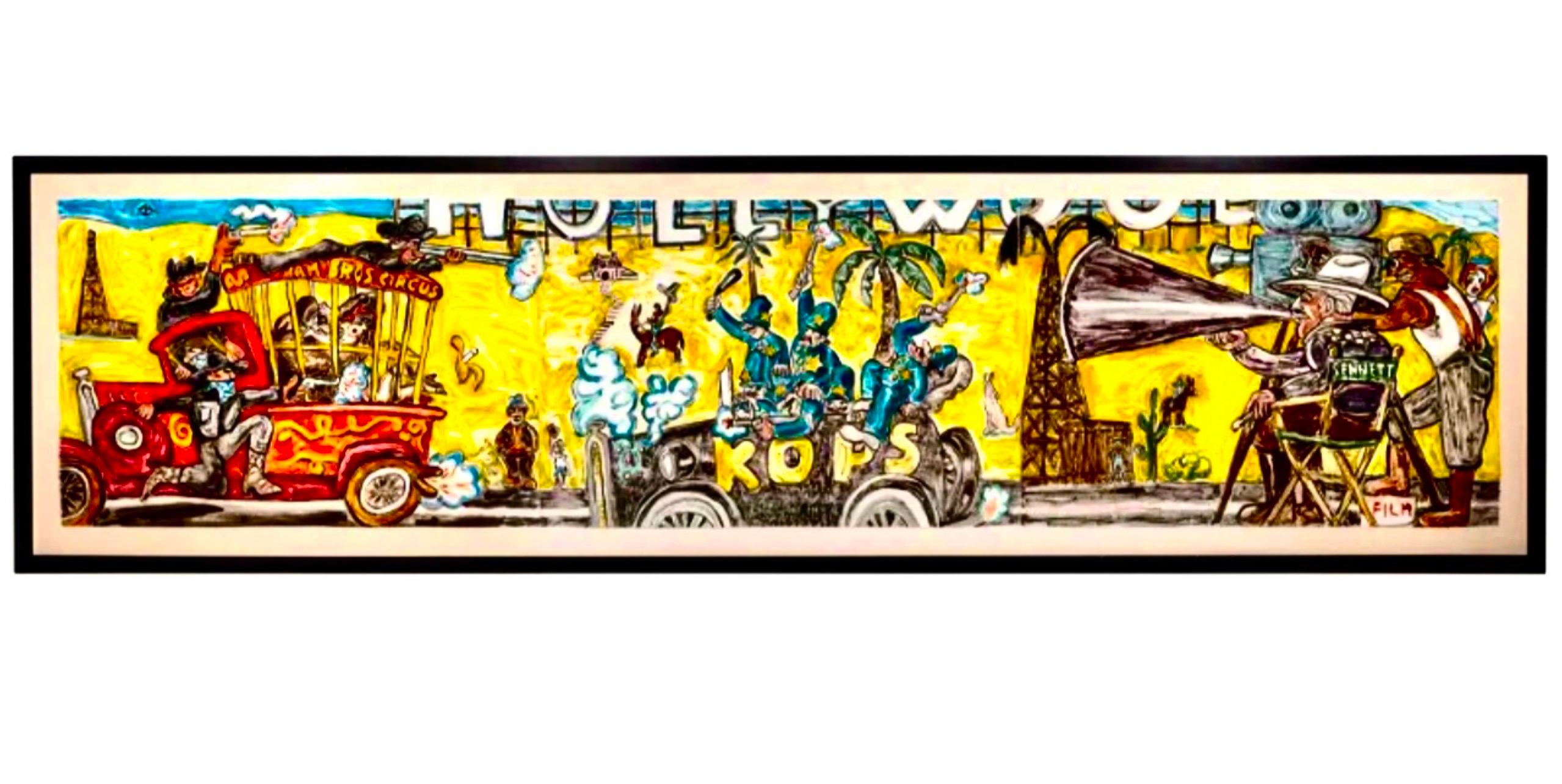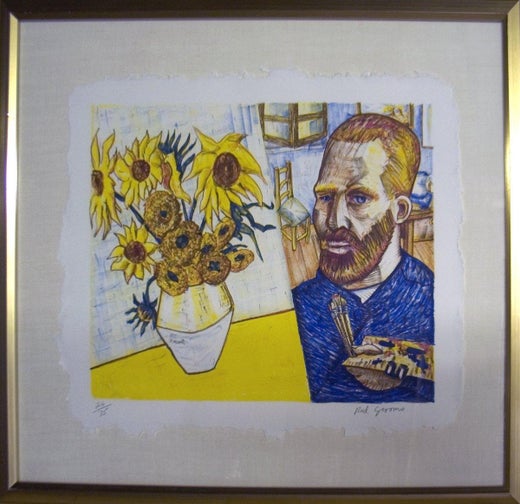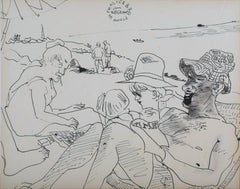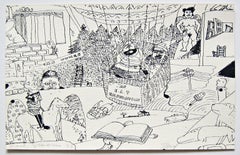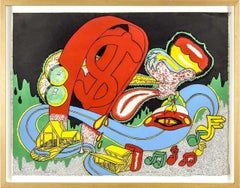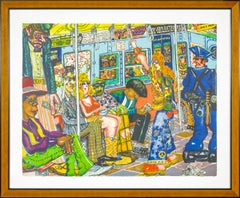Items Similar to Ruckus Rodeo, unique acrylic painting by famed Pop artist, signed, framed, label
Want more images or videos?
Request additional images or videos from the seller
1 of 8
Red GroomsRuckus Rodeo, unique acrylic painting by famed Pop artist, signed, framed, label1975
1975
$10,000
£7,591.83
€8,683.43
CA$13,971.45
A$15,539.30
CHF 8,114.14
MX$189,096.78
NOK 103,629.96
SEK 97,186.62
DKK 64,807.79
Shipping
Retrieving quote...The 1stDibs Promise:
Authenticity Guarantee,
Money-Back Guarantee,
24-Hour Cancellation
About the Item
Red Grooms
Ruckus Rodeo, 1975
Acrylic and felt tip pen on paper
Signed and dated in black felt marker
Unique work
Provenance: Marlborough-Gerson Gallery, with original label verso
Frame included: in museum frame with UV plexiglass
Measurements:
22.75 inches vertical by 19.75 inches horizontal by 1.5 inches
Work
16.5 inches vertical by 13.5 inches horizontal
This work on paper, Ruckus Rodeo, is a unique study by Red Grooms for one of the most popular works of art in the Museum of Modern Art, Ft. Worth, Texas's collection. Ruckus Rodeo is an immense, walk-through work of art that covers 1,237 square feet of gallery space. It consists of painted two-dimensional surfaces and sculptural three-dimensional figures that re-create the Fort Worth rodeo. Grooms has referred to this work as a "sculpto-pictorama." Sculpture wire, canvas, burlap, acrylic paint, and a fiberglass compound known as celastic were used to construct the work’s Texas-sized, larger-than-life, three-dimensional caricatures of rodeo archetypes, which include the rodeo queen and her steed, a bucking bronc, playful rodeo clowns, and a giant yellow bull named Butter.
Ruckus Rodeo was commissioned for the Museum's 1976 exhibition The Great American Rodeo. Grooms was one of eleven artists invited to create a work for this show. In preparation, he attended every rodeo performance during Fort Worth's 1975 Stock Show and made many sketches. From these studies, Grooms drew a panoramic rodeo scene spanning more than seven feet, which served as the basis for Ruckus Rodeo's design. Grooms returned to his studio in New York to fabricate the work's major figures. In 1976, he returned to Fort Worth with the talented fifteen-member group of painters, sculptors, engineers, and carpenters known as the "Ruckus Construction Co.," who helped in the final assembly of Grooms's robust tableau.
Associate Curator Andrea Karnes commented, "Ruckus Rodeo portrays the chaos, entertainment, and danger of the Fort Worth rodeo. Grooms's engaging work is characterized by a grand sense of spectacle, encompassing the ritual, pageantry, and disorderly commotion of a real rodeo event. The artist's interest in naive and primitive objects, such as folk art puppets and toys, is easily seen in this work. His rich, arbitrary use of bold and unmodulated colors combined with angular contours creates a loud, brash ambience. Despite the work's cartoonish flair, it is clearly inflected with an urban sensibility. The characters' outfits, for example, are more like the vibrant apparel of the urban cowboy than the typical dusty clothing of a working cowboy. Grooms has managed to balance naivete and sophistication, parody and reality. Ruckus Rodeo celebrates the grand heritage of Fort Worth and the mythology of the American West, and continues to be one of the most beloved works in the Modern's collection."
- Creator:Red Grooms (1937, American)
- Creation Year:1975
- Dimensions:Height: 22.75 in (57.79 cm)Width: 19.75 in (50.17 cm)Depth: 1.5 in (3.81 cm)
- Medium:
- Movement & Style:
- Period:
- Condition:In original artist's studio condition.
- Gallery Location:New York, NY
- Reference Number:1stDibs: LU1745215069332
Red Grooms
Charles Roger Grooms was born in 1937 in Nashville, Tennessee, a city that, with its lively honky-tonk scene and the theatricality of the historic Grand Ole Opry, would later influence much of his work. Nicknamed for his ginger hair, Red enrolled at the Art Institute of Chicago in 1955. A self-proclaimed “restless and undisciplined student,” Grooms spent the next few years moving between schools and cities, including the New School in New York, Peabody College (now part of Vanderbilt University) in Nashville, and Hans Hofmann’s summer school in Provincetown, Massachusetts. Frustrated with the academic track and anxious to enter the New York art scene, Grooms abandoned formal education to focus exclusively on creating art and securing exhibition opportunities in his Chelsea neighborhood. There, he found quick success and a supportive circle of artists that became close friends and collaborators. From the start of his career, Grooms has worked in multiple media, from painting, printmaking, and sculpture, to installation art, filmmaking, and theatrical experiences known as “Happenings.” Much of his art blurs the boundaries between these different forms, such as his large-scale, carefully-crafted environments he calls “sculpto-pictoramas,” and smaller objects like Dalí Salad. In this example, Grooms combines silkscreened and lithographic elements with a wooden base and acrylic dome to create a three-dimensional portrait of the famous Surrealist artist. Grooms is perhaps best known for his colorful and comedic commentary on the culture, politics, and figures associated with the American urban environment and art historical traditions. Relying on satire and caricature, Grooms’ art has paid homage to a wide range of artists including Rembrandt, Auguste Rodin, Thomas Eakins, and Benjamin West, as well as national icons like Thomas Jefferson and Chuck Berry. Grooms’ disparate output is so difficult to classify that he has been compared to the influential Dada artist, Marcel Duchamp. Like Duchamp, Grooms often deliberately confronts the art world establishment, noting in 1974 that “it’s good to have . . . something to go against.” Despite his affinity for defying the mainstream, Grooms is routinely cited by scholars as one of the leading American artists of his generation and was honored with the National Academy of Design’s Lifetime Achievement Award in 2003. The subject of a 1984 mid-career retrospective exhibition held at the Pennsylvania Academy of the Fine Arts, the artist’s work can be found in public collections across the United States, including the Metropolitan Museum of Art, the Whitney Museum of American Art, and the Hirshhorn Museum and Sculpture Garden, as well as in many international museums. - The Johnson Collection, Spartanburg, South Carolina
About the Seller
5.0
Platinum Seller
Premium sellers with a 4.7+ rating and 24-hour response times
Established in 2007
1stDibs seller since 2022
443 sales on 1stDibs
Typical response time: 2 hours
- ShippingRetrieving quote...Shipping from: New York, NY
- Return Policy
Authenticity Guarantee
In the unlikely event there’s an issue with an item’s authenticity, contact us within 1 year for a full refund. DetailsMoney-Back Guarantee
If your item is not as described, is damaged in transit, or does not arrive, contact us within 7 days for a full refund. Details24-Hour Cancellation
You have a 24-hour grace period in which to reconsider your purchase, with no questions asked.Vetted Professional Sellers
Our world-class sellers must adhere to strict standards for service and quality, maintaining the integrity of our listings.Price-Match Guarantee
If you find that a seller listed the same item for a lower price elsewhere, we’ll match it.Trusted Global Delivery
Our best-in-class carrier network provides specialized shipping options worldwide, including custom delivery.More From This Seller
View AllRed Grooms, Unique drawing of Provincetown Mass. beach, Pop Art Signed, framed
By Red Grooms
Located in New York, NY
RED GROOMS
(Untitled), for Alice + Bo, Provincetown 1966
Original ink drawing on paper
Signed, inscribed and dated with a dateline of Provincetown on recto.
Vintage frame included
Th...
Category
1960s Pop Art Figurative Drawings and Watercolors
Materials
Ink
Red Grooms, "Expedition" (aka "EAT", aka "Stockholm Print") Signed/N, Framed
By Red Grooms
Located in New York, NY
Red Grooms
"Expedition" (aka "EAT", aka "Stockholm Print"), 1973
Silkscreen on 100% rag paper
Pencil signed, dated and numbered recto (front); Stamped in black on verso "© Copyright ...
Category
1970s Pop Art Abstract Prints
Materials
Screen
Study #26, 1960s Gouache painting Signed Framed Pace & Hudson Gallery provenance
By Jack Youngerman
Located in New York, NY
Jack Youngerman
Untitled Study #26, 1967
Gouache painting on paper (with original JL Hudson and PACE Gallery labels)
Hand signed and dated '67 on the front; J.L. Hudson Gallery Label on Verso.
Unique Abstract Expressionist work on paper
Frame included
Framed
Measurements:
Framed:
15 inches by 15 inches by 1.5 inch
Artwork:
7.75 inches by 7.5 inches
Provenance
From the estate of Anne Markley Spivak
J. L. Hudson Gallery Label affixed to verso (back).
The J.L. Hudson Gallery, Detroit, Michigan
This 1967 unique, signed gouache painting by renowned abstract expressionist painter Jack Youngerman was acquired from the estate of Anne Markley Spivak. It is held in the original vintage metal frame with the original J.L. Hudson Gallery label, as well as the PACE gallery label on the verso
The artwork has been newly loated and framed in a museum quality white wood frame; the original labels from the original back board have been affixed to the back to preserve provenance.
Jack Youngerman Biography
Jack Youngerman was born in St. Louis, Missouri on March 25, 1926. He moved to Louisville, Kentucky in 1929 and studied at the University of Missouri, Columbia from 1944 to 1946 under a wartime navy training program. He graduated from the University of North Carolina Chapel Hill in 1947 and, that same year, he returned to Missouri to finish his Bachelor’s degree in Journalism before moving to Paris on a G.I. scholarship.
In Paris, Youngerman enrolled at the Ecole des Beaux-Arts, studying drawing with Jean Souverbie. He explored Paris, taking in the cathedrals, museums, and history in order to grasp a greater sense of art history. He also traveled to the Netherlands, Spain, Belgium, Italy, and Greece on fine art excursions.
In 1948, Youngerman became friends with Ellsworth Kelly, Eduardo Paolozzi, and Cesar – fellow students at Ecole des Beaux-Arts. He married Delphine Seyrig in 1950, and later that year he had his first group exhibition at Galerie Maeght in Paris. He visited the studios of Constantín Brancusi and Jean Arp and became heavily influenced by the organic forms present in their work. He also met artist Alexander Calder through his father-in-law, Henri Seyrig, and experimental filmmaker and artist, Robert Breer...
Category
1960s Abstract Expressionist Abstract Paintings
Materials
Gouache
Peter Saul, Golden Gate Bridge, Pop Art social satire lithograph Signed/N Framed
Located in New York, NY
Peter Saul
Golden Gate Bridge, 1968
Five color lithograph on German etching paper with deckled edges with collectors press chop mark
Hand signed, titled and numbered "Artist Proof" lower front; also bears Collector's Press chop mark, and chop mark of master printer Tony Ko
Frame Included: floated and framed in the original wood frame
Provenance: from the Estate of the legendary California artist, Roy DeForest
Accompanied by a copy of the publisher's documentation sheet (see image)
Also accompanied by gallery issued Certificate of Guarantee
This work is one of three hand signed Artist's Proofs, aside from the regular edition of 50. It is one of Peter Saul's most celebrated prints; the not so subtle at all symbolism speaks for itself, such as the gigantic dollar sign and wagging tongue (money talks loudly), set against San Francisco's iconic Golden Gate bridge.
This print does not often appear on the market, as so many from this edition are already in the permanent collection of major museums and institutions.
Other examples of this work were featured in the exhibitions:
"Print Retrospective, 1966-2010", from September 16 – December 22, 2011 at the Carl Solway Gallery in Ohio, and "Peter Saul: Prints and Drawings, 1960 -1975", from February 26 – April 11, 2009, at The George Adams Gallery...
Category
1960s Pop Art Abstract Prints
Materials
Etching, Lithograph
Roy De Forest, Dog lithograph, signed/n by world renowned California pet painter
By Roy De Forest
Located in New York, NY
Roy De Forest
Untitled (Dog), 1981
Color lithograph with deckled edges. Floated and framed.
Pencil signed and numbered from the edition of 125
Frame Included: held in original vintage white frame
Wonderful whimsical rare 1981 lithograph by the incredibly popular and beloved Roy de Forest, famous for his paintings and prints of dogs...
Category
1980s Surrealist Animal Prints
Materials
Lithograph
Red Feat (Lloyd, 73) Signed/N silkscreen by pioneering British Pop Artist Framed
By Allen Jones
Located in New York, NY
Rare coveted silkscreen in museum quality frame:
Allen Jones
Red Feat (Lloyd, 73), 1976
Lithograph on Arches paper
Hand signed, dated and numbered 49/60 in pencil recto, with Landfal...
Category
1970s Pop Art Abstract Prints
Materials
Lithograph
You May Also Like
Study for Way Down East, Pop Art Color Pencil Drawing by Red Grooms
By Red Grooms
Located in Long Island City, NY
Artist: Red Grooms
Title: Study for Way Down East
Year: circa 1965
Medium: Color Pencil and Watercolor on Paper, Signed verso
Size: 17.5 x 22 inches
Frame: 26 x 32 inches
"Way Down East" is best known as a 1920 American silent romantic drama film directed by D. W. Griffith and starring Lillian Gish...
Category
1960s Pop Art Figurative Drawings and Watercolors
Materials
Watercolor, Color Pencil
Hand-signed "Local" lithograph by Red Grooms from the 1971 "No Gas" portfolio
By Red Grooms
Located in Boca Raton, FL
"Local" lithograph by Red Grooms from the 1971 "No Gas" portfolio. Hand-signed AP Red Grooms in policeman's left shoe in bottom lower right of image. Depicts people on subway.
Category
1970s Contemporary Figurative Prints
Materials
Lithograph
Bicentennial Bandwagon, Pop Art Lithograph by Red Grooms
By Red Grooms
Located in Long Island City, NY
Bicentennial Bandwagon by Red Grooms, American (1937)
Date: 1975
Offset Lithograph (unsigned as issued)
Image Size: 10 x 13 inches
Size: 14 in. x 17 in. (35.56 cm x 43.18 cm)
Frame S...
Category
1970s Pop Art Figurative Prints
Materials
Offset
Stockholm Print, Framed Pop Art Screenprint by Red Grooms 1973
By Red Grooms
Located in Long Island City, NY
Artist: Red Grooms, American (1937 - )
Title: Stockholm Print, from the New York Collection for Stockholm
Year: 1973
Medium: Silkscreen, signed and nu...
Category
1970s Pop Art Figurative Prints
Materials
Screen
Hand-signed and numbered "Rat" lithograph from "No Gas Portfolio" by Red Grooms
By Red Grooms
Located in Boca Raton, FL
"Rat" lithograph from 1971 "No Gas" portfolio by Red Grooms. Hand-signed AP Red Grooms inside blue of Clorox bottle on front lower right. Image size: 22 x 27 1/2 inches. Depicts a N...
Category
1970s Contemporary Figurative Prints
Materials
Lithograph
Huge Red Grooms Monotype Oil Painting LA Hollywood Circus Film Cartoon Pop Art
By Red Grooms
Located in Surfside, FL
Red Grooms (American, b. 1937).
Keystone Kops to the Rescue III. 2006.
Triptych color monotype created by the artist with lithographic ink on plexiglass plates, and then hand-colored by the artist.
Printed by master printer Bud Shark.
Printed on White Rives BFK.
A unique impression, signed by the artist in pencil lower right.
3 sheets. Each sheet is 30 x 44 ½ ”. Overall: 30 x 133 ½ ”
This has all the wonderful components of a Red Grooms piece, Keystone Kops policemen, Circus, Cactus, Cowboys, Hollywood sign etc.
Red Grooms (born Charles Rogers Grooms on June 7, 1937) is an American multimedia artist best known for his colorful pop-art constructions depicting frenetic scenes of modern urban life. Grooms was given the nickname "Red" by Dominic Falcone (of Provincetown's Sun Gallery) when he was starting out as a dishwasher at a restaurant in Provincetown and was studying with Hans Hofmann.
Grooms was born in Nashville, Tennessee during the middle of the Great Depression. Red Grooms came of age in the shadow of the Abstract Expressionists. He studied at the Art Institute of Chicago, then at Nashville's Peabody College. In 1956, Grooms moved to New York City, to enroll at the New School for Social Research. A year later, Grooms attended a summer session at the Hans Hofmann School of Fine Arts in Provincetown, Massachusetts. There he met experimental animation pioneer Yvonne Andersen, with whom he collaborated on several short films. Grooms follows in the tradition of William Hogarth and Honoré Daumier, who were canny commentators on the human condition. In 1969, Peter Schjeldahl compared Grooms to Marcel Duchamp, because both embodied "a movement of one man that is open to everybody."
In the spring of 1958, Grooms, Yvonne Andersen and Lester Johnson each painted twelve-foot by twelve-foot panels, which they erected with telephone poles on a parking lot adjacent an amusement park in Salisbury, MA. Inspired by artist-run spaces such as New York's Hansa Gallery and Phoenix, and Provincetown's Sun Gallery, Grooms and painter Jay Milder opened the City Gallery in Grooms' second-floor loft in the Flatiron District. When Phoenix refused to show Claes Oldenburg, Grooms and Milder dropped out of Phoenix and City Gallery presented Oldenberg's first New York exhibition, as well as that of Jim Dine. Other artists who showed at City Gallery include Stephen Durkee, Mimi Gross (daughter of Chaim Gross and Red Grooms wife), Bob Thompson, Lester Johnson, and Alex Katz. Grooms never developed the detached stance of such Pop Art practitioners as Andy Warhol, Roy Lichtenstein or James Rosenquist. Instead he painted his own life, and became, literally, an actor on the stage of life -- in this case the art-as-life "happenings" of the downtown New York scene. Inspired by George Méliès...
Category
Early 2000s Pop Art Figurative Paintings
Materials
Monoprint, Monotype
